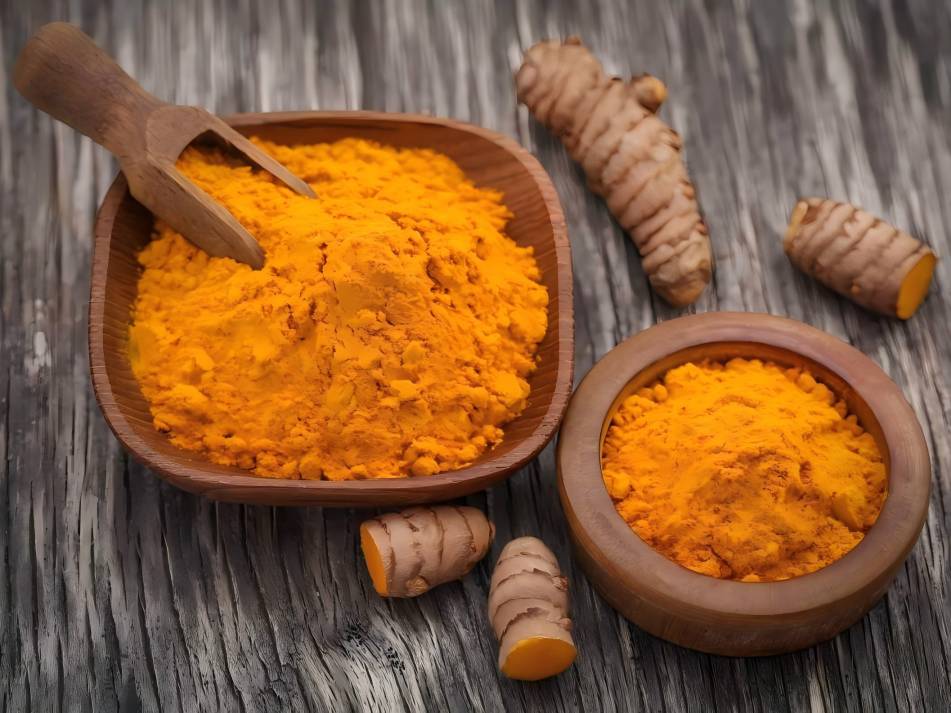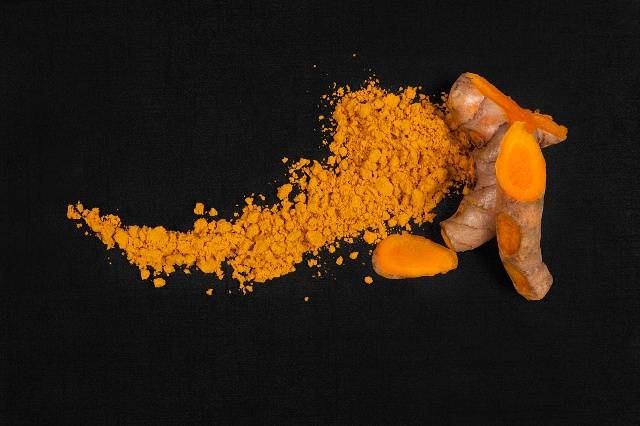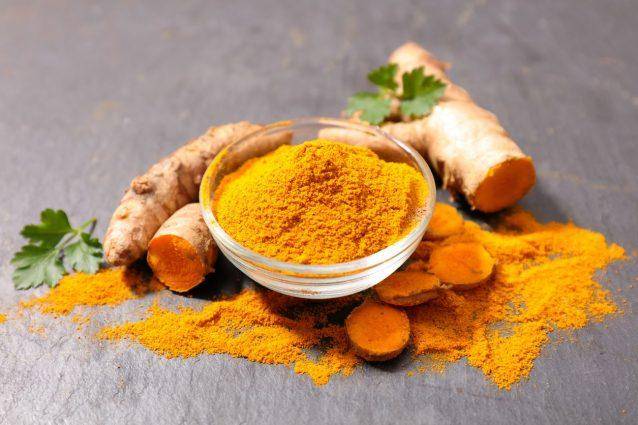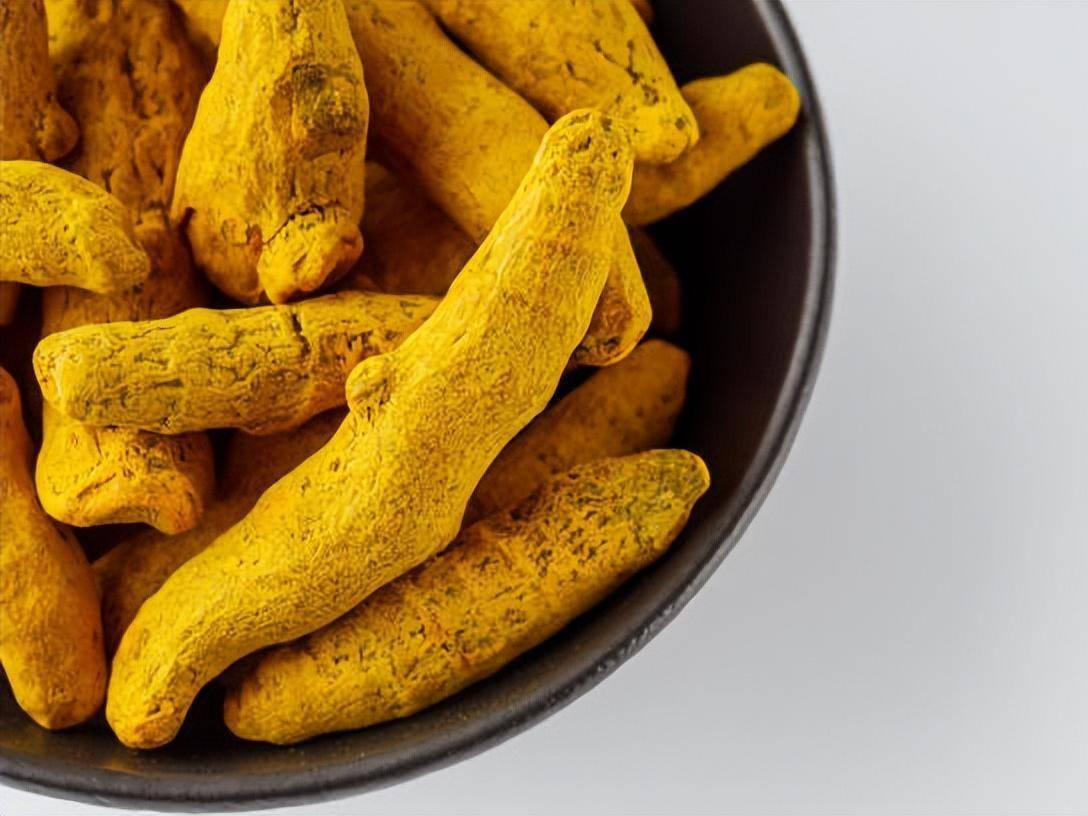What Is Curcumin in Hindi?
Curcumin is a natural polyphenolic compound extracted from the dried rhizomes of turmeric and other ginger plants [1]. It is an orange-yellow crystalline powder with a slightly bitter taste. It is insoluble in water and ether. Its chemical molecular formula is C21H20O6. It mainly contains curcumin, demethoxycurcumin and bisdemethoxycurcumin (see Figure 1 for the structure). Curcumin accounts for the highest proportion, about 70% or so, and is also the main component responsible for its pharmacological effects [2].
It contains two phenylpropanoid backbones, with one phenolic hydroxyl group and one methoxy group on each benzene ring, and the propylene group is connected to a β-diketone/enol structure. Turmeric has been cultivated and used for thousands of years. It originated in India, where it is an important part of Ayurvedic medicine, and is believed to have the effects of relieving flatulence, expelling worms, improving digestion, reducing inflammation, and treating liver disease [3-4]. In China, turmeric was first recorded in the “Tang Materia Medica” and was used to break blood and promote circulation of Qi, unblock the channels and relieve pain. Currently, curcumin is one of the world's best-selling natural food colors [5] and is widely used in the food industry. It can be found in a variety of products such as beverages, candy, pasta, and compound seasonings.
At the same time, modern medical research has proven that curcumin has a variety of physiological functions, such as anti-inflammatory, scavenging active oxygen free radicals and anti-oxidation, regulating intestinal flora, protecting the cardiovascular system, anti-tumor, repairing brain damage, improving blood sugar levels, and preventing Alzheimer's disease [6-13]. However, the low solubility, unstable chemical structure and rapid metabolic process in the body of natural curcumin seriously affect its bioavailability [4], which has imposed certain limitations on its practical application [2].
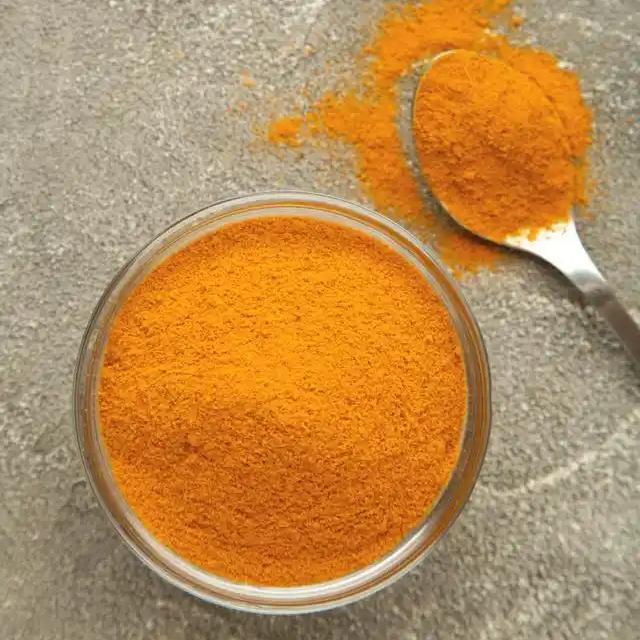
Encapsulating and modifying curcumin is an effective way to improve its stability and increase its solubility and bioavailability. Encapsulated delivery systems for curcumin are also a current research hotspot [14], which provides a solid technical support for expanding the application of curcumin in the fields of food and medicine. With the promotion and implementation of the “Healthy China 2030” plan, people's health awareness is becoming stronger and stronger. Curcumin is an active polyphenol, and the development and application of its physiological functions will have a positive impact on improving people's health. Therefore, this paper aims to review the physiological functions of curcumin and the progress of its research and application, with a view to providing theoretical support and developing new ideas for the application of curcumin in the fields of food and medicine.
1 Physiological functions of curcumin
The application of curcumin in nutritional health care has been widely practiced in traditional medicine. Modern medicine has explored its physiological functions through a large number of in vivo, in vitro and clinical trials, and found that the physiological functions of curcumin are mainly reflected in the following aspects.
1.1 Antioxidant effect
The balance between oxidants and the antioxidant defence system in living organisms
is maintained by the neutralizing effect of antioxidant enzymes and reducing substances. Free radicals are a highly oxidizing group produced during biological metabolism. When produced in excess, the oxidation balance is disrupted, oxidative stress occurs in the cell, and serious metabolic disorders in the organism result. Studies have shown that the presence of peroxidation reactions and oxidative damage is closely linked to the development of chronic diseases.
Yu H B et al. [15] verified that curcumin can reduce the production of reactive oxygen species in cells by simulating an Alzheimer's disease cell model; Wang Xuemei et al. [7] demonstrated through a controlled study of curcumin and rutin that curcumin can effectively scavenge superoxide anion radicals and hydroxyl radicals; Asouri M et al. [16] used the DPPH method to determine the scavenging ability of curcumin for free radicals and that at a concentration of 0.1 mmol/L, the scavenging rate of curcumin for free radicals was greater than 69%. Reactive oxygen species (ROS) interacting with lipids can cause lipid peroxidation. MAD is one of the products of lipid peroxidation. Studies have found that curcumin at certain concentrations can reduce the intracellular MDA content [17].
Li Guanghui et al. [18] studied the effect of curcumin on the antioxidant properties of the blood and tissues of Roman chickens and found that feeding different doses of curcumin can increase the enzymatic activities of catalase (CAT), superoxide dismutase (SOD) and glutathione peroxidase (GSH-Px), which improves the antioxidant properties of the chicken body. The antioxidant effect was better when the curcumin was added at a dosage of 200 mg/ kg of feed, the antioxidant effect is better. Wang Yahui et al. [19] found that feeding turbot fry with turmeric-enriched feed increased serum SOD and CAT activities compared to the control group, enhancing serum antioxidant capacity. Other studies have found that curcumin can improve the antioxidant capacity of the body in egg-laying hens, inhibit the oxidation of lipids and proteins in ducklings, and enhance the growth capacity and antioxidant levels of lambs [20-22].
The ability of curcumin to scavenge free radicals is related to the phenolic hydroxyl group in its molecular structure. The presence of a methoxy group may promote this antioxidant activity, but some scholars believe that the antioxidant effect of curcumin is achieved by the phenolic group and methoxy group linking to the 1,3-diketone-bound double bond system [23]. Curcumin may regulate the antioxidant activity by upregulating the expression of the endogenous antioxidant factor Nrf2 via the Nrf2-ARE pathway, and then regulating the transcription of antioxidant enzymes (SOD, CAT, GSH-Px) [24]. The specific mechanism is shown in Figure 2. In summary, curcumin can inhibit lipid peroxidation by scavenging ROS (such as superoxide anions, hydrogen peroxide, and hydroxyl radicals), and achieve antioxidant effects by enhancing the activity of antioxidant enzymes to achieve antioxidant effects and prevent chronic diseases.
1.2 Anti-inflammatory effects
Inflammation is a natural protective response of cells to secrete NO and pro-inflammatory factors when tissues are damaged. Modern medical research has found that the development of many chronic diseases in the human body is related to long-term inflammation. Curcumin is considered to be an active substance with anti-inflammatory activity comparable to existing anti-inflammatory drugs and with high safety [25]. It can exert anti-inflammatory effects through different pathways. Studies have shown that curcumin can promote the degradation of the inflammation-mediating enzyme inducible nitric oxide synthase (iNOS) in lipopolysaccharide (LPS)-induced RAW 264.7 inflammatory model cells [26], and can also inhibit IL-17-induced NO synthesis and iNOS expression in human keratinocytes [27]. Prostaglandins (PGs) in the body are synthesized from the substrate arachidonic acid (AA) by cyclooxygenase (COX), and are involved in inflammatory responses and pain.
Curcumin can inhibit the synthesis of PG in cells by inhibiting cyclooxygenase (COX-1 and COX-2) [28-29]. Curcumin also exhibits a significant inhibitory effect on other inflammatory factors. Long Mingzhi et al. [30] used a rabbit iliac artery intima balloon injury model to study the effect of drug intervention on intimal hyperplasia after vascular injury, and found that the content of interleukin IL-6 in the turkeys in the curcumin group was significantly lower than that in the other groups.
Jiang Bing et al. [31] established a model of rheumatoid arthritis (RA) in rats and studied the anti-inflammatory effect of curcumin on RA rats. They found that curcumin treatment can inhibit the expression of interleukin (IL-1) and TNF-α in rats. Chen Yanyan et al. [32] found that curcumin treatment can reduce the levels of TNF-α and interleukins (IL-1β, IL-6, and IL-10) in the spinal cord homogenate of rats with acute spinal cord injury.
NF-κB is an important transcription factor that plays an important role in inflammatory responses by regulating the expression of inflammation-related genes through gene transcription. Curcumin can reduce the inflammatory response in rats with acute lung injury (ALI) by regulating the NF-κB pathway [33], reduce the inflammatory symptoms in the paws of rats with arthritis [34], and reduce the symptoms of pneumonia in young mice infected with Mycoplasma [35]. In summary, curcumin exerts its anti-inflammatory effect mainly by regulating the NF-κB signaling pathway and inhibiting the production of iNOS, cyclooxygenase and inflammatory factors. The specific regulatory mechanism is shown in Figure 2. These studies also provide some theoretical support for the potential medicinal value of curcumin in anti-inflammatory, anti-mycoplasma infection, anti-rheumatoid arthritis and improving skin inflammatory diseases.
1.3 Protecting the cardiovascular system
Cardiovascular disease is a systemic or systemic vascular disease that manifests in the heart. It is characterized by a high prevalence, high disability rate, and high mortality rate. A large number of studies have proven that curcumin has a protective effect on the cardiovascular system. In ischemic cardiomyocytes during myocardial infarction, the levels of lysosomal hydrolases increase and the production of oxygen free radicals causes damage to the infarcted myocardium [9]. Curcumin intervention in rats with myocardial infarction induced by isoproterenol was found to reduce lysosomal hydrolase activity by scavenging oxygen free radicals, restore cell membrane stability in rats with myocardial infarction, and reduce myocardial necrosis in rats [9].
Arteriosclerosis is one of the important causes of cardiovascular disease. Wang Haixiong et al. [36] observed autophagosomes using transmission electron microscopy and found that curcumin can inhibit ox-LDL-induced autophagy in HUVECS cells and may protect against atherosclerosis in this way. Numerous animal studies have shown that reducing intestinal cholesterol absorption can reduce the risk of atherosclerosis. Intestinal cholesterol absorption is mediated by the NPC1L1 protein. Curcumin can reduce cholesterol absorption by inhibiting the intestinal expression of the NPC1L1 protein [37]. The adaptive expansion of the heart caused by various stresses is expressed as cardiac hypertrophy. Sustained pathological expansion will eventually lead to heart failure and death. Endogenous histone acetyltransferase (HAT) p300, a transcription cofactor, plays an important role in the development and progression of pathological cardiac hypertrophy and heart failure.
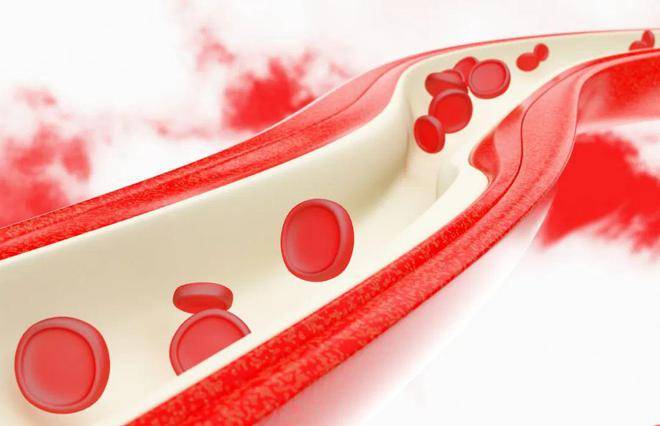
Experimental data show that p300 overexpression in the mouse heart leads to cardiac hypertrophy and ultimately heart failure [38]. Curcumin has been shown to be a natural p300-HAT inhibitor and could potentially be used as a therapeutic agent for cardiac hypertrophy and heart failure. Myocardial fibrosis is a chronic ischemic heart disease that, like cardiac hypertrophy, gradually progresses to heart failure. Angiotensin II is one of the important cytokines that cause myocardial fibrosis. Curcumin can improve myocardial fibrosis symptoms by regulating the Ang II type 1 receptor and type 2 receptor-dependent signal pathways and activating the angiotensin converting enzyme 2 (ACE2)-mediated myocardial fibrosis regulatory mechanism [39]. Curcumin may also improve myocardial fibrosis in diabetic rats through the TGF-β/Smads signaling pathway [40]. In summary, curcumin has potential in the prevention of many cardiovascular diseases, but its protective mechanism for the cardiovascular system is not fully understood, and more extensive and in-depth research is needed in animal in vivo verification experiments and clinical trials.
1.4 Regulating the intestinal microbiota
The intestinal flora is an important part of the intestine and is crucial to maintaining homeostasis. It is known as the body's “microbial organ” and is closely related to host health. It can metabolize and produce products such as short-chain fatty acids, and is linked to the body's immune and hormonal systems through the “gut-brain axis” and “gut-liver axis”, synergistically regulating host metabolism and other functions [41]. Studies have found that curcumin can regulate the composition and abundance of intestinal flora, promote the transformation of pathogenic flora to beneficial flora, and achieve a protective effect on intestinal health [8]. Bacteriostatic tests have found that curcumin significantly inhibits the growth of Salmonella and Staphylococcus aureus [42].
Curcumin can improve the flora disorder induced by sodium dextran sulfate in mice with colitis, significantly increase the abundance of bacteria such as Bacteroides and Enterococcus, and significantly reduce the abundance of bacteria such as Enterococcus, Leuconostoc, Faecalibacterium and Clostridium perfringens [43]. It has also been found that curcumin can maintain intestinal microbial homeostasis by reducing the relative abundance of Proteobacteria and the ratio of Firmicutes/Bacteroidetes, thereby improving propylene glycol-induced hepatic steatosis in mice [44]. Curcumin also has the effect of improving the physique of farmed animals and poultry and enhancing the quality of livestock and poultry meat by regulating the composition of the intestinal microorganisms in the body. For example, it can improve the feed efficiency of Jinhua pigs during the fattening period, regulate lipid deposition in the host and improve the quality of pork [45], and improve the intestinal microbial environment and growth performance of broiler chickens [46-47].
Zhou F N et al. [48] found that curcumin can improve the composition of the intestinal flora in mice with inflammatory bowel disease and improve liver metabolic disorders through the “gut-liver axis”. The “gut-brain axis” is considered to be a potential therapeutic target for Parkinson's disease. Based on this, Cai B C et al. [49] found that curcumin can improve Parkinson's disease by regulating the composition of the intestinal flora and short-chain fatty acid levels in model mice.
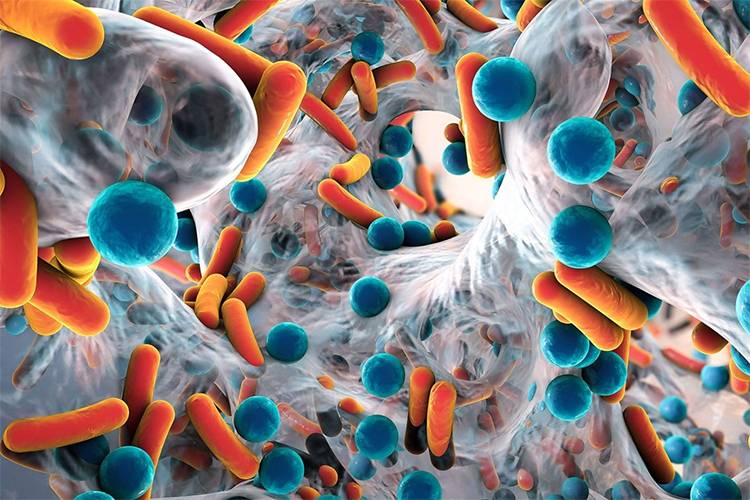
Hong T et al. [50] found that curcumin can prevent bile-cholesterol supersaturation by increasing the abundance of bacteria involved in bile acid metabolism and short-chain fatty acid production, and inhibiting intestinal cholesterol absorption. saturation. It is worth mentioning that due to the different intestinal flora composition of different individuals, there may be individual differences in the effect of curcumin on regulating host body function through intestinal microorganisms. In addition, the active products of curcumin after microbial decomposition in the intestine may further act on the intestinal flora, and their biological activity may be higher than that of curcumin itself. The bioavailability of curcumin is low, and its health benefits may be achieved by regulating the composition and metabolism of intestinal microorganisms, but there are currently insufficient reports in this area. In the future, the mechanism by which curcumin exerts its health effects through interactions with intestinal microorganisms needs to be explored in greater depth.
1.5 Other physiological functions
In addition to the above physiological functions, the health effects of curcumin in other areas should not be ignored. Curcumin can inhibit the proliferation and differentiation of cancer cells and induce apoptosis of cancer cells to achieve an anti-tumor effect. The US National Cancer Institute has listed it as a third-generation chemopreventive agent. Existing research results show that curcumin and its derivatives can be used as potential therapeutic agents for various cancers such as prostate cancer, esophageal cancer, pancreatic cancer, colon cancer and breast cancer [1, 51]. Several studies have shown that curcumin can promote nerve regeneration as a neuroprotective substance, and it has a significant repair effect on traumatic brain injury, ischemic reperfusion brain injury, chronic ischemic brain injury, and hypoxic brain injury [52-55]. Curcumin can also lower blood glucose and blood lipid levels in diabetic rats [56], and reduce brain damage in diabetic rats by regulating inflammatory and oxidative stress pathways, thereby reducing the complications of diabetes [57].
At the same time, studies have found that curcumin can dissolve amyloid proteins and repair the nerve damage caused by these proteins, playing a role in preventing Alzheimer's disease [58]. Curcumin is also considered to be a potential anti-thrombotic drug that can be used to make drug-eluting stents to prevent thrombosis [59]. Li Honglong et al. [60] investigated the effect of water-soluble curcumin on thrombosis and inflammation resolution using a zebrafish model. They found that curcumin can significantly inhibit thrombosis at ≥ 1000 μg·mL-1, and that at the same administration concentration, water-soluble curcumin preparations can better inhibit thrombosis and inflammation than ordinary curcumin. In addition, it has been found that curcumin can inhibit the differentiation of preadipocytes to mature adipocytes by regulating the metabolism of adipocytes, and induce the expression of adiponectin, a major anti-inflammatory agent secreted by adipocytes, thereby reducing the occurrence of obesity and its impact on health [61-62].
2 Research on curcumin nanocarriers
Curcumin has poor water solubility and low stability, and it degrades rapidly at physiological pH, resulting in poor pharmacokinetics and low bioavailability. Nanocarriers have small particle sizes and high stability. Encapsulating curcumin using nanotechnology can prolong the release period, enhance the water solubility and targeting properties, and improve the stability and bioavailability of curcumin [63-64]. The encapsulation and delivery of curcumin using nanocarriers is currently a major research focus. The principle of constructing curcumin nanocarriers is usually that curcumin is combined with nanocarrier materials through non-covalent bonds such as hydrogen bonds, π-π stacking, van der Waals forces, and electrostatic interactions, or it is covalently coupled to chemical groups on the surface of the nanomaterial through covalent bonds [14]. Curcumin nanocarrier complexes prepared using different nanomaterials are quite different.
Cheng Yang et al. [65] used a complex of myristoyl erythritol monostearate and ethyl laurate as a raw material to prepare curcumin nanoliposomes with an encapsulation rate of 94.6%. The curcumin release rate can quickly reach above 98% at 37 °C and 42 °C. Other studies have shown that curcumin nanoliposomes have significantly improved solubility and stability compared to free curcumin, and exhibit equivalent antioxidant activity in cells [66]. Nanoparticles have strong permeability and high stability. Studies have shown that poly(lactic-co-glycolic acid) (PLGA)-curcumin nanoparticles have good biocompatibility and can effectively reduce the content of pro-inflammatory cytokines [67]. Meng R et al. [68] prepared nanoparticles with different mass ratios using corn protein and carboxymethyl dextrin (CMD) as raw materials.
When the mass ratio of corn protein to CMD was 2:1, the size of the nanoparticles was the smallest ( 212 nm), the curcumin encapsulation rate increased by 85.5%, and the photothermal stability and antioxidant activity were significantly enhanced. Nanoemulsions can control the solubility and efficacy of active substances by controlling droplet size, and their application in improving the bioavailability of curcumin has been well demonstrated. Relevant efficacy evaluations have shown that curcumin nanoemulsion technology can significantly improve the antioxidant, anti-inflammatory and anti-cancer activities of curcumin [69]. The application of curcumin nanoemulsions to milk can improve lipid oxidation in milk and improve milk quality [70].
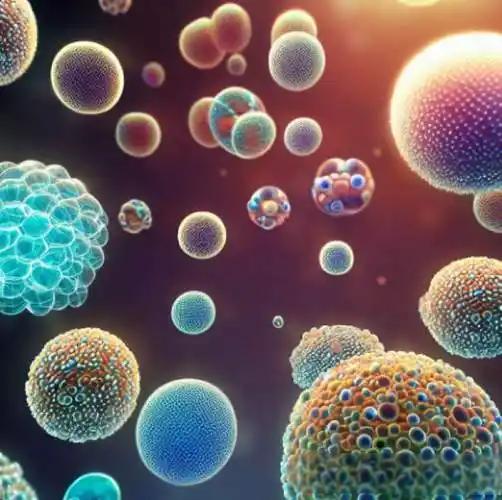
Fan Ziliang et al. [71] prepared curcumin nanomicelles using ε-PLL-UNA as the carrier material by dialysis, with a drug loading capacity of 12.22% ± 2.13% and an encapsulation rate of up to 85.12% ± 3.64%. In vitro cell experiments showed that the release rate of curcumin from the micelles was 84% after 48 hours, and it was quickly uptake, and the inhibitory effect on the growth of glioma cell spheres is significantly better than that of curcumin solution. Sun Wu Qian et al. [72] used the film dispersion method to prepare Cur/MP nano-micelles using methoxy polyethylene glycol-polycaprolactone (MP) as the raw material. The average encapsulation rate of the micelles was 97.52% ± 1.00%, and the average drug loading was 5.25% ± 0.80%. The curcumin release rate could reach a maximum of 7 4.16%, with a significant sustained-release effect, and the inhibitory effect on human non-small cell lung cancer A549 cells is also better than that of curcumin solution. Celebioglu A et al. [73] found that curcumin and CyD can form a stable complex, which can be used to prepare curcumin/cyclodextrin (CyD) nanofibrous networks. Compatibility testing and dissolution/disintegration testing showed that the nanofibrous network can significantly improve the water solubility of curcumin and enhance its antioxidant activity.
In summary, the main curcumin nanocarriers currently studied and applied include nanoliposomes, nanoparticles, nanocapsules, nanomicroemulsions, nanofibers, etc. Among them, nanoliposomes are the most widely used in industrial applications due to their high biocompatibility and biodegradability, low toxicity, ability to encapsulate hydrophobic and hydrophilic compounds, and good targeting. All kinds of nanocarriers can improve the bioavailability of curcumin and improve the effect of curcumin. However, there are still some urgent problems to be solved in these research applications, such as the mismatch between the theoretical research level and the actual application process, low conversion rate, high preparation cost, and lack of toxicological testing. How to further improve the bioavailability of curcumin and the safety of various carriers based on the improvement of existing defects, and optimize the preparation process of various technologies, is worthy of more in-depth research.
3 Application of curcumin in the food industry
China is currently one of the world's major turmeric producers and has a good advantage in terms of raw materials. The continuous improvement of food safety standards also provides theoretical guidance for the development and application of curcumin in the food industry. The Standard for the Use of Food Additives (GB2760-2014) [74] stipulates the following for the use of curcumin in food: the maximum permitted use of curcumin in cocoa products, chocolate and chocolate products, and candy is 0.01 g/kg; the maximum permitted use in frozen drinks is 0.15 g/kg; the maximum permitted use in batter, breadcrumbs, and frying powder is 0.3 g /kg, and the maximum allowable use of curcumin in convenience rice and flour products, flavored syrups, condiments, and carbonated drinks is 0.50, 0.50, 0.10, and 0.01 g/kg, respectively. It can be used in cooked nuts and seeds, fillings for grain products, and puffed foods in appropriate amounts according to production needs.
At present, the main applications of curcumin in the food industry involve food coloring, compound seasoning, and health preservation. For details, see Table 1. In terms of coloring, as one of the widely used natural pigments, curcumin is extracted from plants, which is safe, reliable, and has no side effects. Its good dyeing and dispersibility make its dyeing power superior to many natural pigments and synthetic pigments [80]. In addition, to meet the coloring needs of different foods, curcumin can also be compounded with other pigments to produce various food-specific pigments with different shades, which can be used in the development of a variety of foods such as beverages, fruit wines, candies, pastries, canned foods, fruit juices, and cooking dishes. Process test results show that curcumin has many advantages as a coloring agent in the production of fruit and vegetable drinks and instant noodles [75-76]. Turmeric has a long history of use as a flavoring agent. Sources of curcumin Turmeric is one of the main flavoring ingredients in traditional Indian curry dishes, Middle Eastern kebabs, Thai food and Persian food [77]. Its unique aroma, which combines the aromas of ginger and orange, and its slightly bitter taste add flavor to food. Curcumin can also be used to color and flavor some dairy products. Today, curcumin is used as a flavoring agent in instant food seasonings, hot pot seasonings, puffed seasonings, chicken seasonings and other compound seasonings [78].
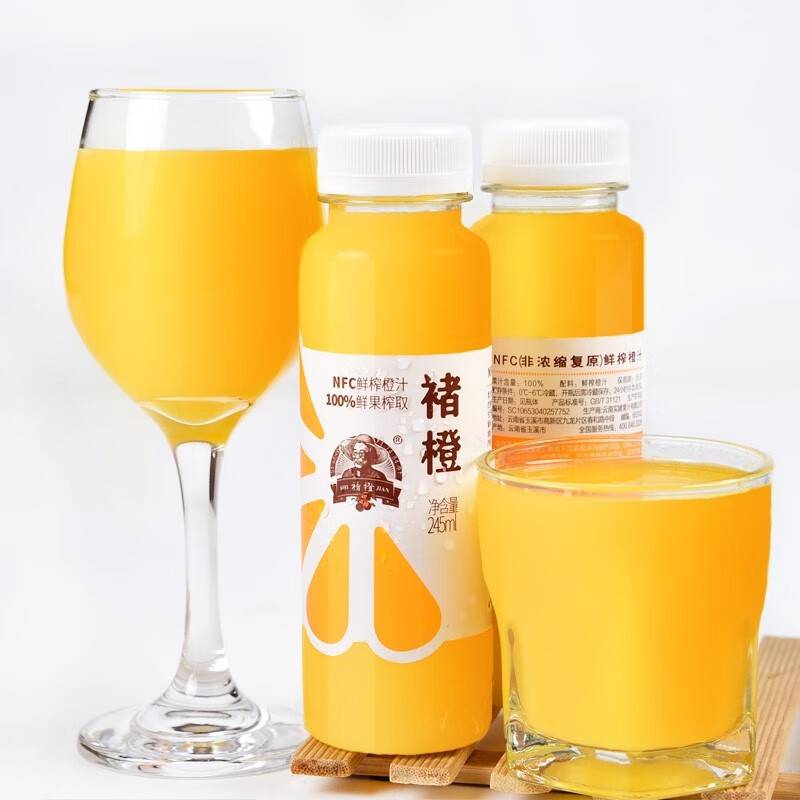
Curcumin has great potential for use in the development of health foods. The curcumin derivative tetrahydrocurcumin has been approved as a novel food resource by the European Union [79]. The characteristics of curcumin as a medicine and food with similar properties and its diverse physiological effects are in line with the current concept of health. More and more companies at home and abroad have begun to research curcumin and have launched a variety of curcumin-related products. The development of curcumin health food is gaining momentum and the market prospects are broad. In the future, as the curcumin market continues to develop, the addition of curcumin as a flavor enhancer in a series of products can simultaneously highlight its wide range of physiological effects and increase the added value of the products. In the development of curcumin health food, in addition to the common capsules, oral liquids, and tablets, conventional functional enhanced foods such as curcumin pastries, drinks, and dairy products can also be launched.
4 Conclusion
Curcumin has a wide range of physiological functions, and its physiological functions have been continuously discovered in recent years. However, its specific mechanism of action still needs to be further explored. Research on improving the low bioavailability of curcumin by encapsulating it in nanocarriers has achieved some results, but there is still much room for optimization. The characteristics of curcumin as a medicine with food homology meet the current consumer demand for health and consumption, and it has good application prospects in the food industry. However, the question of what process will be used in the future to better apply curcumin in the food industry still requires further exploration by practitioners in the food industry and practitioners in other industries.
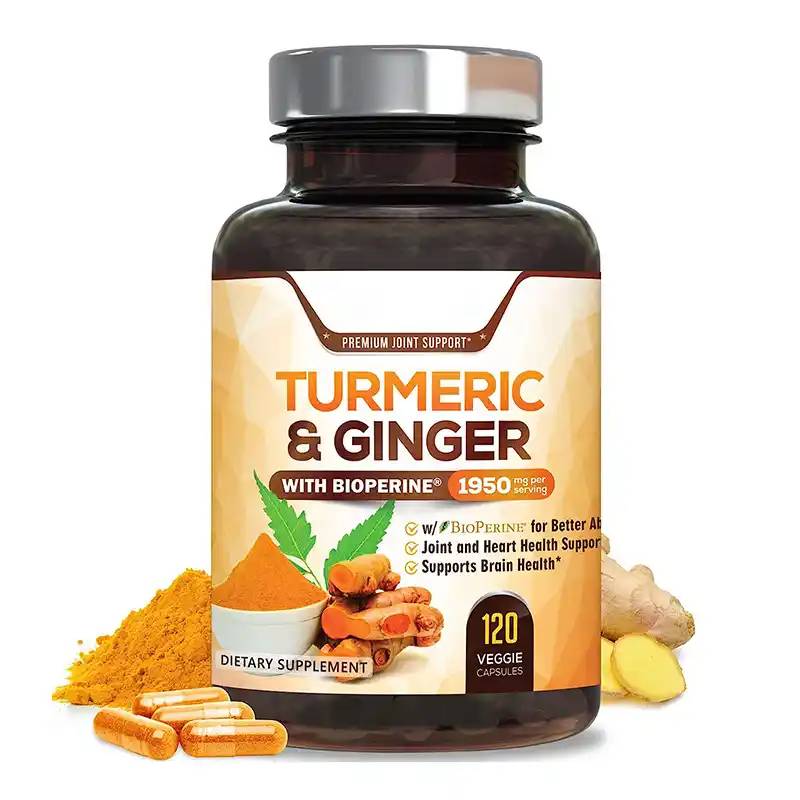
References:
[1] Wang Zi-tian, Zhou Rong-xue. Research progress on the physiological functions of curcumin [J]. Beverage Industry, 2019, 22(1): 68-70.
[2] Liu Jia, Huang Yuhong, Wang Baohe, et al. Research progress on the in vivo metabolic pathways of curcumin-like compounds and their metabolites [J]. Modern Drugs and Clinics, 2015, 30 (12): 1553-1557.
[3] Chen Bojun. Turmeric: the “Queen of the Kitchen” with its bright orange color [J]. Encyclopedia Knowledge, 2023 (5): 38-45.
[4] Wang Haonan, Qiu Zhehan, Tian Wenni, et al. Research progress on the in vivo absorption and metabolism of curcumin and its interaction with intestinal flora [J]. Chinese Journal of Food Science, 2023, 23 (2): 353-364.
[5] Stig Bengmark, Liu Qing. Research progress of the plant-derived preservative curcumin [J]. Modern Drugs and Clinical Practice, 2009, 24(1): 22-31.
[6] Zheng Zhaoling. Research progress of curcumin's anti-inflammatory and immune-modulating effects [J]. Shanxi Traditional Chinese Medicine, 2008, 24(3): 48-49.
[7] Wang Xuemei, Zhang Jiansheng, Gao Yuntao, et al. Research on the in vitro scavenging of active oxygen free radicals and antioxidant effects of curcumin [J]. Food Industry Science and Technology, 2008, 29(7): 94-95, 98.
[8] Chen Xinyu, Pan Shifeng, Xing Hua, et al. Research progress on the interaction between curcumin and intestinal microorganisms [J]. Journal of Animal Nutrition, 2023, 35(2): 782-788.
[9] Li Na, Zheng Bin. Research progress on the cardiovascular protective effect of curcumin and its analogues [J]. Strait Pharmacy, 2017, 29(12): 1-5.
[10] Lin Youwen, Chen Limin, Zhou Youqing, et al. Microwave synthesis of curcumin analogues and study of their antitumor activity [J]. Chinese Journal of New Drugs, 2010, 19(7): 622-624.
[11] Yang Youlian, Zhang Xin, Luo Yang, et al. Curcumin improves the inflammatory response and prognosis of traumatic brain injury in rats [J]. Modern Medicine and Health, 2015, 31(20): 3056-3058, 3061.
[12] Tian Shuo, Bai Ming, Miao Mingsan, et al. Effect of curcumin on a rat model of diabetes [J]. Pharmacology and Clinical of Traditional Chinese Medicine, 2017, 33(2): 53-55.
[13] Sun T, Zhang D, Jing Y. Curcumin's therapeutic effects on Alzheimer's disease and its mechanism [J]. Chinese Journal of Pharmacology and Toxicology, 2021, 35(9): 641.
[14] Cao Jiayong, Liu Yuan, Zhou Jie, et al. Research progress in the preparation and application of curcumin nanocarriers [J]. Food Industry, 2023, 44(8): 187-192.
[15]Yu H B ,Yamashita T ,Hu X ,et al. Protective and anti- oxidative effects of curcumin and resveratrol on Aβ - oligomer-induced damage in the SH-SY5Y cell line [J] . Journal of the Neurological Sciences ,2022,441 :120356.
[16]Asouri M,Ataee R,Ahmadi A A ,et al. Antioxidant and free radical scavenging activities of curcumin [J]. Asian Journal of Chemistry ,2013 ,25(13):7593-7595.
[17]Haryuna T S H ,Fauziah D,Anggraini S ,et al. Antioxidant effect of curcumin on the prevention of oxidative damage to the cochlea in an ototoxic rat model based on malondialdehyde expression [J]. International Archives of Otorhinolaryngology, 2021 ,26(1):e119-e124.
[18] Li Guanghui, Zhong Xiuling, Aamir Nawab, et al. Effect of curcumin on the antioxidant properties of blood and tissues of Roman chickens [J]. Anhui Agricultural Science, 2018, 46 (21): 96-99.
[19] Wang Yahui, Wang Yuyu, Mai Kangsen, et al. Effects of curcumin supplementation in feed on growth, body composition and antioxidant enzyme activity of juvenile turbot (Scophthalmus maximus) [J]. Journal of Fisheries of China, 2016, 40(9): 1299-1308.
[20] Zhou Binghua, Yang Gang, Su Yijing, et al. The effect of thymol and curcumin in combination on the growth performance, antioxidant capacity and intestinal morphology of broiler chicks infected with Salmonella enteritidis [J]. Feed Industry, 2023, 44 (21): 52-59.
[21]Jin S J ,Yang H ,Liu F J ,et al. Effect of dietary curcumin supplementation on duck growth performance ,antioxidant capacity and breast meat quality [J]. Foods ,2021 ,10(12): 2981.
[22]Marcon H ,Souza C F ,Baldissera M D ,et al. Effect of curcumin dietary supplementation on growth performance, physiology ,carcass characteristics and meat quality in lambs [J]. Annals of Animal Science ,2021 ,21(2):623-638.
[23] Wang C, Jing H. Research progress on the anti-inflammatory and antioxidant effects of curcumin [J]. Medical Postgraduate Journal, 2012, 25(6): 658-660.
[24] Li C. The role of JNK2 in the prevention of cardiovascular complications in mice with type 1 diabetes by the curcumin derivative C66 [D]. Changchun: Jilin University, 2019.
[25] Di Jianbin, Gu Zhenlun, Zhao Xiaodong, et al. Research progress on the antioxidant and anti-inflammatory effects of curcumin [J]. Chinese Herbal Medicine, 2010, 41(5): 854-857.
[26] Ben P L ,Liu J H ,Lu C Y ,et al. Curcumin promotes degradation of inducible nitric oxide synthase and suppresses its enzyme activity in RAW 264.7 cells [J] . International Immunopharmacology ,2011 ,11(2):179-186.
[27] Yang Zhengsheng, Peng Zhenhui, Li Xiaoli, et al. Effect of curcumin on NF-κB activation in IL-17-induced human epidermal keratinocyte cells [J]. Chinese Journal of Dermatology and Venereology, 2011, 25(11): 842-844, 847.
[28] Tan X ,Poulose E M ,Raveendran V V ,et al. Regulation of the expression of cyclooxygenases and production of prostaglandin I2 and E2 in human coronary artery endothelial cells by curcumin [J]. Journal of Physiology and Pharmacology ,2011 ,62(1):21-28.
[29]Mohan M,Hussain M A,Khan F A ,et al. Symmetrical and un-symmetrical curcumin analogues as selective COX-1 and COX-2 inhibitor [J] . European Journal of Pharmaceutical Sciences ,2021 ,160 :105743.
[30] Long Mingzhi, Chen Leilei, Yang Jiming, et al. Anti-inflammatory and antioxidant effects of curcumin and its effect on intimal hyperplasia after vascular injury [J]. Jiangsu Medicine, 2003, 29(10): 735-737.
[31] Jiang Bing, Zhang Bosen, Zhang Gang. Anti-inflammatory effect of the traditional Chinese medicine curcumin on rats with rheumatoid arthritis
anti-inflammatory effect [J]. Xinjiang Traditional Chinese Medicine, 2017, 35(3): 64-67.
[32] Chen Yanyan, Zhou Shujuan, Xia Yuchao, et al. Intervention effect of curcumin on inflammatory factors in rats with acute spinal cord injury [J]. Asia-Pacific Traditional Medicine, 2020, 16(12): 20-22.
[33] Xiao Xuefei, Yang Mingshi, Sun Shenghua. Effects of curcumin on inflammatory response and NF-κB signaling pathway in acute lung injury of sepsis [J]. Chinese Journal of Modern Medicine, 2013, 23(30): 19-22.
[34] Abd -Elhale m S S ,Al -Doori M H ,Hassen M T. Macrophage polarization towards M2 phenotype by curcuminoids through NF-κB pathway inhibition in adjuvant- induced arthritis [J] . International Immunopharmacology, 2023 ,119 :110231.
[35] Wang Zhihua, Liu Xinhui, Li Jing, et al. Preliminary study on the anti-inflammatory effect and mechanism of curcumin on young mice with pneumonia caused by Mycoplasma pneumoniae infection [J]. Journal of Clinical Pulmonology, 2022, 27(1): 12-16.
[36] Wang Haixiong, Li Jun, Li Na, et al. Research on the protective effect and mechanism of curcumin on atherosclerosis by inhibiting autophagy [J]. Electronic Journal of Integrated Traditional Chinese and Western Medicine Cardiovascular Disease, 2021, 9(2): 10-12.
[37]Zou J ,Zhang S S ,Li P Y ,et al. Supplementation with curcumin inhibits intestinal cholesterol absorption and prevents atherosclerosis in high-fat diet–fed apolipoprotein E knockout mice [J]. Nutrition Research ,2018 ,56 :32-40.
[38]Wongcharoen W ,Phrommintikul A. The protective role of curcumin in cardiovascular diseases [J]. International Journal of Cardiology ,2009 ,133(2):145-151.
[39]Pang X F,Zhang L H,Bai F ,et al. Attenuation of myocardial fibrosis with curcumin is mediated by modulating expression of angiotensin II AT1/AT2 receptors and ACE2 in rats [J]. Drug Design,Development and Therapy,2015 ,9 :6043-6054.
[40] Shen Hao, Guo Shuang, Liu Xiufen, et al. The role of the TGF-β/Smads signaling pathway in curcumin improving myocardial fibrosis in diabetic rats [J]. Chinese Journal of Pharmacology, 2018, 34(4): 522-527.
[41] Cheng Yongxia. Preparation of longan juice rich in oligofructose by enzymatic method and its functional research [D]. Guangzhou: South China Agricultural University, 2019.
[42] Zhong Yingying, Huang Xiaochang, Chen Shiyi. Study on the in vitro antibacterial activity of curcumin [J]. Anhui Agricultural Science, 2010, 38(34): 19369-19370, 19377.
[43] Guo X X ,Xu Y ,Geng R X ,et al. Curcumin alleviates dextran sulfate sodium-induced colitis in mice through regulating gut microbiota [J] . Molecular Nutrition & Food Research ,2022 ,66(8):e2100943.
[44]Hong T ,Jiang X ,Zou J ,et al. Hepatoprotective effect of curcumin against bisphenol A-induced hepatic steatosis via modulating gut microbiota dysbiosis and related gut-liver axis activation in CD-1 mice [J]. The Journal of Nutritional Biochemistry ,2022 ,109 :109103.
[45] Lou Fangfang, Chen Yushi, Liu Yuxi, et al. Effects of curcumin on growth performance, meat quality, lipid metabolism and intestinal microflora of Jinhua pigs during the fattening period [J]. Chinese Journal of Animal Science, 2023, 59(8): 308-315.
[46] Sun Quanyou, Xu Bin, Wang Linyi, et al. Effects of antimicrobial peptide and curcumin on growth performance, antioxidant function and intestinal microflora of broiler chickens [J]. Chinese Poultry, 2015, 37(20): 32-36.
[47] Sun Quanyou, Li Wenjia, Xu Bin, et al. Effects of curcumin and Bacillus licheniformis on growth performance, serum antioxidant function, intestinal microbial quantity and immune organ index of broilers [J]. Journal of Animal Nutrition, 2018, 30(8): 3176-3183.
[48]Zhou F N ,Mai T ,Wang Z R ,et al. The improvement of intestinal dysbiosis and hepatic metabolic dysfunction in dextran sulfate sodium-induced colitis mice :Effects of curcumin [J]. Journal of Gastroenterology and Hepatology, 2023 ,38(8):1333-1345.
[49]Cai B C,Zhong L F,Wang Q T ,et al. Curcumin alleviates 1-methyl- 4-phenyl- 1 ,2 ,3 ,6-tetrahydropyridine- induced Parkinson ’s disease in mice via modulating gut microbiota and short-chain fatty acids [J] . Frontiers in harmacology ,2023 ,14 :1198335.
[50]Hong T ,Zou J ,Jiang X ,et al. Curcumin supplementation ameliorates bile cholesterol supersaturation in hamsters by modulating gut microbiota and cholesterol absorption [J] . Nutrients ,2022 ,14(9):1828.
[51]Mbese Z ,Khwaza V ,Aderibigbe B A. Curcumin and its derivatives as potential therapeutic agents in prostate ,colon and breast cancers [J]. Molecules ,2019 ,24(23):4386.
[52] Liang Lan, Wei Huiping, Sun Yan, et al. Antioxidant stress effect of curcumin in a rat model of traumatic brain injury [J]. Chinese Journal of Comparative Medicine, 2018, 28 (4): 73-80, 92.
[53] Wang N, Chen K, Guo W, et al. Effects of curcumin on hippocampal neuronal apoptosis and PI3K signal factor expression in rats with cerebral ischemia-reperfusion [J]. Advances in Anatomical Sciences, 2017, 23(1): 34-37.
[54] Yang Liu, Zhang Min, He Xi, et al. Protective effect and molecular mechanism of curcumin on chronic cerebral ischemia-induced brain injury in rats [J]. China Pharmaceutical Industry, 2015, 24(4): 31-34.
[55] Yin Guangmei, Yu Linsheng, Wu Shuzhen, et al. Effects of curcumin on MDA changes, caspase-3 expression and apoptosis in brain tissue of rats with cerebral ischemia-reperfusion injury [J]. Chinese Journal of Applied Physiology, 2010, 26(4): 504-506, 529.
[56] Wang Zhenfu, Zhong Ling. Experimental study on the preventive and therapeutic effects of curcumin on diabetes in rats [J]. Chinese Journal of Applied Physiology, 2014, 30(1): 68-69, 73.
[57] Miao C F ,Chen H B ,Li Y L ,et al. Curcumin and its analog alleviate diabetes-induced damages by regulating inflammation and oxidative stress in brain of diabetic rats [J]. Diabetology & Metabolic Syndrome ,2021 ,13(1):21.
[58] Yang Ronghui, Zhang Ning. Research progress on the mechanism of curcumin in Alzheimer's disease [J]. Journal of Southeast University: Medicine Edition, 2015, 34 (1): 152-155.
[59] Pan C J ,Shao Z Y ,Tang J J ,et al. In vitro studies of platelet adhesion ,activation ,and protein adsorption on curcumineluting biodegradable stent materials [J]. Journal of Biomedical Materials Research Part A ,2007 ,82(3):740-746.
[60] Li Honglong, Wang Mingming, Jin Ziheng, et al. Anti-thrombotic and anti-inflammatory activities of water-soluble curcumin preparations based on the zebrafish model [J]. Drug Evaluation Research, 2023, 46 (10): 2172-2178.
[61] Kasprzak-Drozd K ,Oniszczuk T ,Gancarz M ,et al. Curcumin and weight loss :Does it work? [J]. International Journal of Molecular Sciences ,2022 ,23(2):639.
[62]Bradford P. Curcumin and obesity [J]. BIOFACTORS,2013, 39(1):78-87.
[63]Dong X M ,Tong Y Y. Curcumin nanoparticles inhibit liver cancer by inhibiting angiogenesis [J]. Science of Advanced Materials ,2021 ,13(10):1878-1884.
[64]Gera M ,Sharma N ,Ghosh M ,et al. Nanoformulations of curcumin :An emerging paradigm for improved remedial application [J]. Oncotarget ,2017 ,8(39):66680-66698.
[65] Cheng Yang, Wei Wei, Jin Qingzhe, et al. Study on the encapsulation and release properties of curcumin by preparing lipid nanocarriers with fatty acid glycerol esters [J]. China Oil and Fat, 2020, 45(10): 62-67.
[66] Chen X ,Zou L Q,Niu J ,et al. The stability ,sustained release and cellular antioxidant activity of curcumin nanoliposomes [J]. Molecules,2015,20(8):14293-14311.
[67] Li Zhen, Hao Kai, He Chaoliang, et al. Preparation and in vitro anti-inflammatory evaluation of PLGA-curcumin nanoparticles [J]. Journal of Chemical Education in Colleges and Universities, 2023, 44 (10): 245-252.
[68] Meng R ,Wu Z Z ,Xie Q T ,et al. Preparation and characterization of zein/carboxymethyl dextrin nanoparticles to encapsulate curcumin :Physicochemical stability ,antioxidant activity and controlled release properties [J]. Food Chemistry, 2021 ,340 :127893.
[69] Jiang T ,Liao W ,Charcosset C . Recent advances in encapsulation of curcumin in nanoemulsions :A review of encapsulation technologies,bioaccessibility and applications [J]. Food Research International ,2020 ,132 :109035.
[70] Chuacharoen T ,Sabliov C M. Comparative effects of curcumin when delivered in a nanoemulsion or nanoparticle form for food applications :Study on stability and lipid oxidation inhibition [J]. LWT ,2019 ,113 :108319.
[71] Fan Ziliang, Jin Binghui, Xu Xiangfang, et al. Preparation and in vitro antitumor evaluation of curcumin-loaded nanomicelles [J]. Journal of Wenzhou Medical University, 2017, 47 (9): 625-630, 636.
[72] Sun Wuqian, Guo Qiuhong, Jia Yuqian, et al. Preparation of curcumin nanomicelles and in vitro antitumor effect study [J]. Huaxi Journal of Pharmacy, 2023, 38(1): 7-11.
[73] Celebioglu A, Uyar T. Fast-dissolving antioxidant curcumin/cyclodextrin inclusion complex electrospun nanofibrous webs [J]. Food Chemistry, 2020, 317: 126397.
[74] National Health and Family Planning Commission. National Food Safety Standard: Food Additive Use Standard: GB 2760-2014 [S]. Beijing: China Standards Press, 2015.
[75] Zhang Baojun, Zhang Wei. The physiological functions of curcumin and its application in instant noodles [J]. China Food Additives, 2001 (4): 37-38, 26.
[76] Fan Shuqi, Zhang Baojun, Li Chunlin. Natural curcumin and its application in fruit and vegetable drinks [J]. China Food Additives, 2002, 13(5): 57-59, 78.
[77] Yuan Peng, Chen Ying, Xiao Fa, et al. Bioactivity and application of curcumin in food [J]. Food Industry Science and Technology, 2012, 33(14): 371-375.
[78] Chen Mengqi, Zhou Mingrui, Han Yahong. Research progress on the application of curcumin in food [J]. China Food Additives, 2022, 33(10): 292-300.
[79] Yang Xiaojing. Last year, the European Union approved the launch of 12 new types of food on the market (Part 2) [N]. China Food News, 2023-02-06.
[80] Niu Shengyang, Hao Fengge, Xu Qiuya. Research progress in the extraction and application of curcumin [J]. Journal of Henan University of Science and Technology: Natural Science Edition, 2008, 36 (4): 58-61.


 English
English French
French Spanish
Spanish Russian
Russian Korean
Korean Japanese
Japanese